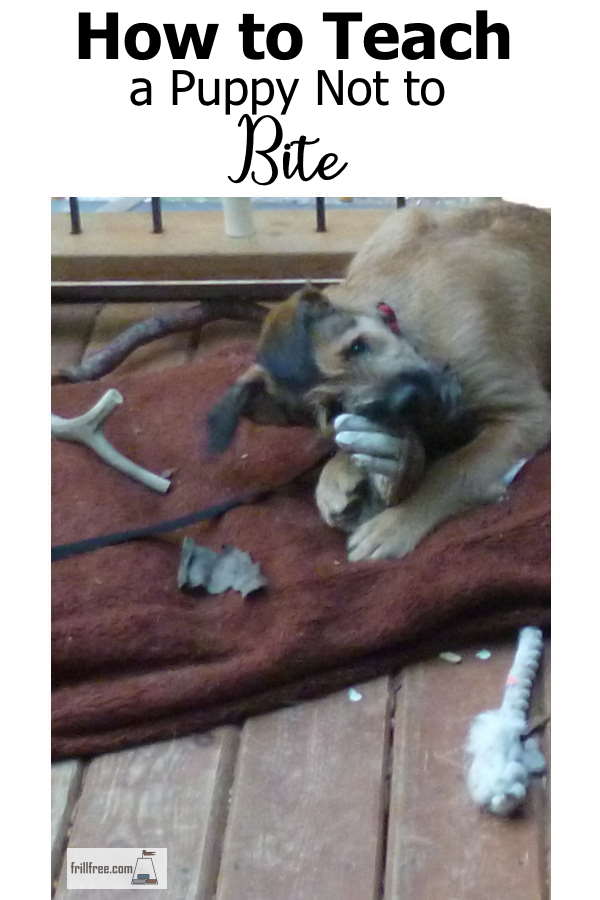- Homesteading
- Critters
- Service Dog DIY
- How to Teach a Puppy Not to Bite
How to Teach a Puppy Not to Bite
or Nip The Hand That Feeds Her
One of the most insidious and frustrating parts of owning a puppy is that it's so difficult to get them out of biting and nipping. Here are a few ways to teach a puppy not to bite (or at least, not so hard!)
Once all the baby teeth fall out and are replaced by those lovely white adult teeth, you could be forgiven for thinking that all your problems with nipping and biting are over.
You would be wrong, however.
It's just getting started, only now, those big sharp shiny adult teeth can do more harm!
By six months old, your fuzzy little puppy is reaching adolescence, and if you have been careful to teach bite inhibition (where they learn not to bite hard because humans are such wimps!) then this part should be fairly easy to handle.
It's so hard to believe that, but the foundation is in place with the early training of using treats to get the pups attention and to back away from your closed fist before they get a treat. This is called 'mugging' if you want to look up more about it.
These methods are all gentle and use force free training - sometimes known as positive reinforcement.
Here are a few ways to get them to respect your delicate skin. Some work better than others on particular dogs, and under particular circumstances;
Teaching a Puppy Not to Bite Technique 1:
Take the pups face gently in both of your palms, one on each side. Don't put any pressure on it, but try to not let them duck away. If they do, you have more work to do on head shyness. If they turn their head to bite you, just very calmly and quietly say 'no bite'.
Keep eye contact. Then when they stop attempting to bite, say 'yes' or whatever your marker is (this is like clicker training, but that's not going to work in this case as both of your hands are being using to hold the pups face).
Use lots of praise ('good girl' etc) then move on to playing a game, use a tug toy or something.
De-Nipping Your Pup Technique 2:
Teach 'kisses' by putting butter or coconut oil on your hands, let the puppy lick the butter, while you say 'ooh, nice kisses' in a very soft gentle voice. If there is anything other than nice kisses, say 'ah ah' but then instantly go back to 'ooh, nice kisses' when they lick again.
Use the cue 'gentle' to teach this skill, so it can carry over to when the puppy meets older people or young children.
Technique 3 for Preventing Biting in Puppies:
If the biting is accompanied by jumping up, use the 'zen' method.
Turn your back on the puppy, even if they continue to jump and nip. Cross your arms over your chest, look up to the sky or to a tree or other object.
Take your attention completely away, but look at them out of the corner of your eye. When they stop jumping and nipping, and throw in some other behaviour (sitting or lying down) instantly turn and praise the pup. Move on to a game or other activity.
Observations and Tips;
Whichever techniques you use, stay calm and make sure everyone in your household is on the same page.
Generally, one person in the pack will have trouble, while the rest of the time the other members will be puzzled at why the puppy continues to nip that particular person.
The reason is usually clear if you take some video footage of their interactions with the puppy. Sometimes they appear to the pup as a weakest member of the pack and the pup is dominating them (as they do).
Other times, there is some kind of encouragement to continue the behaviour, like pushing the puppy away, kneeing them, yelling at them. This just encourages the behaviour, and in fact is reinforcing it.
In concert with this type of behaviour modification, it's important to give her things that she's allowed to bite, like bully sticks, chew toys and raw bones.
And, a lot of exercise. I recommend using a tennis ball or other ball to teach them to retrieve, making a flirt which you can use sitting down so they learn to 'give' when asked, and other similar games.
If they are biting when you try to walk them, use the techniques above first, and leave the walking for a while. There is no point in letting the behaviour become firmly entrenched.
For biting on the leash, I train them the cue 'leave it' but that's a whole other kettle of fish.
Zak George is one of my go-to trainers who uses the same kind of positive reinforcement techniques that I love;












